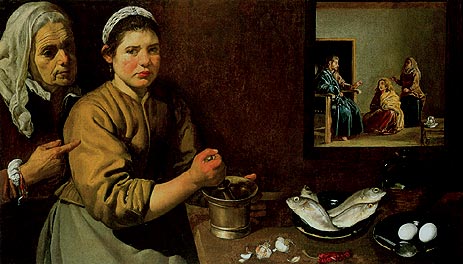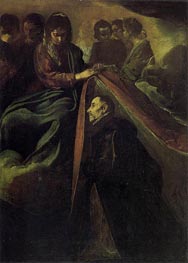Christ in the House of Martha and Mary, 1618 Diego Rodriguez de Silva Velazquez (1599-1660)
Location: National Gallery London UKOriginal Size: 60 x 103.5 cm
Own a museum-quality reproduction of Christ in the House of Martha and Mary by Velazquez (1618), exclusively hand-painted in oils on linen canvas by European artists with academic training. Each masterpiece is created with meticulous craftsmanship, capturing the exceptional quality and authentic brushwork of the original painting.


Recreating Velazquez: A Video Journey into Museum-Quality Reproductions by TOPofART
Video showcasing the process of hand-painting a Velazquez masterpiece with the utmost precision and care for detail.
Oil Painting Reproduction
If you want a different size than the offered
Description
Painted by European Аrtists with Academic Education
Museum Quality
+ 4 cm (1.6") Margins for Stretching
Creation Time: 8-9 Weeks
Creation Process
We create our paintings with museum quality and covering the highest academic standards. Once we get your order, it will be entirely hand-painted with oil on canvas. All the materials we use are the highest level, being totally artist graded painting materials and linen canvas.
We will add 1.6" (4 cm) additional blank canvas all over the painting for stretching.
High quality and detailing in every inch are time consuming. The reproduction of Diego Rodriguez de Silva Velazquez also needs time to dry in order to be completely ready for shipping, as this is crucial to not be damaged during transportation.
Based on the size, level of detail and complexity we need 8-9 weeks to complete the process.
In case the delivery date needs to be extended in time, or we are overloaded with requests, there will be an email sent to you sharing the new timelines of production and delivery.
TOPofART wants to remind you to keep patient, in order to get you the highest quality, being our mission to fulfill your expectations.
We not stretch and frame our oil paintings due to several reasons:
Painting reproduction is a high quality expensive product, which we cannot risk to damage by sending it being stretched.
Also, there are postal restrictions, regarding the size of the shipment.
Additionally, due to the dimensions of the stretched canvas, the shipment price may exceed the price of the product itself.
You can stretch and frame your painting in your local frame-shop.
Delivery
Once the painting Christ in the House of Martha and Mary is ready and dry, it will be shipped to your delivery address. The canvas will be rolled-up in a secure postal tube.
We offer free shipping as well as paid express transportation services.
After adding your artwork to the shopping cart, you will be able to check the delivery price using the Estimate Shipping and Tax tool.
Museum Quality
The paintings we create are only of museum quality. Our academy graduated artists will never allow a compromise in the quality and detail of the ordered painting. TOPofART do not work, and will never allow ourselves to work with low quality studios from the Far East. We are based in Europe, and quality is our highest priority.
Additional Information

The Venerable Mother Jeronima de la Fuente 1620
$2658
$62.64
Diego Rodriguez de Silva Velazquez
Original Size:160 x 110 cm
Prado Museum, Madrid, Spain

The Adoration of the Magi 1619
$3825
$62.11
Diego Rodriguez de Silva Velazquez
Original Size:203 x 125 cm
Prado Museum, Madrid, Spain

St. Idelfonso Receiving Chasuble from the Virgin c.1620
$1267
Diego Rodriguez de Silva Velazquez
Original Size:203 x 125 cm
Museo de Bellas Artes, Seville, Spain

The Triumph of Bacchus c.1628/29
$7407
$113.34
Diego Rodriguez de Silva Velazquez
Original Size:165 x 225 cm
Prado Museum, Madrid, Spain

The Forge of Vulcan c.1630
$3706
$120.63
Diego Rodriguez de Silva Velazquez
Original Size:223 x 290 cm
Prado Museum, Madrid, Spain